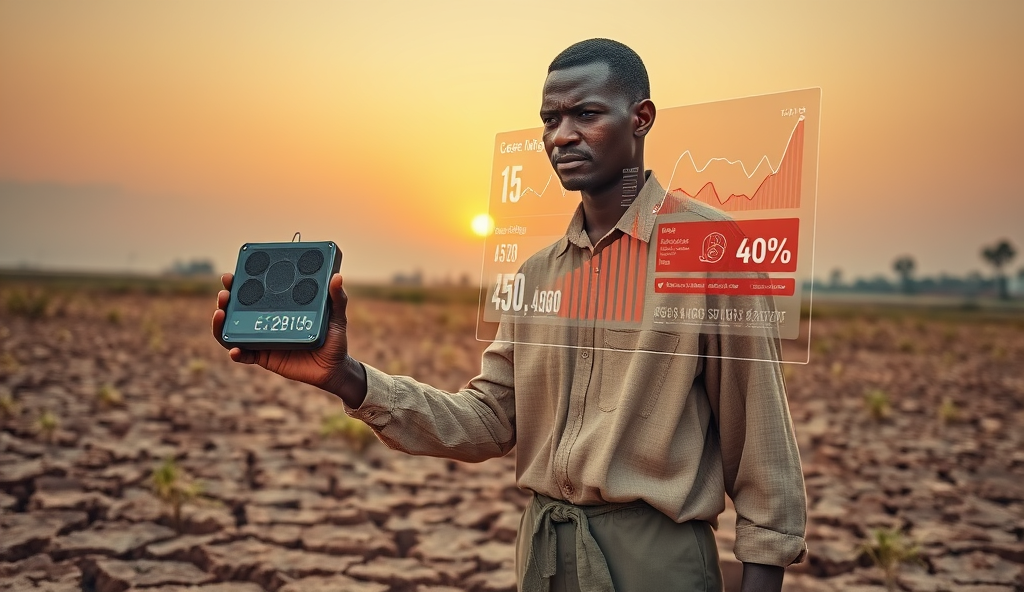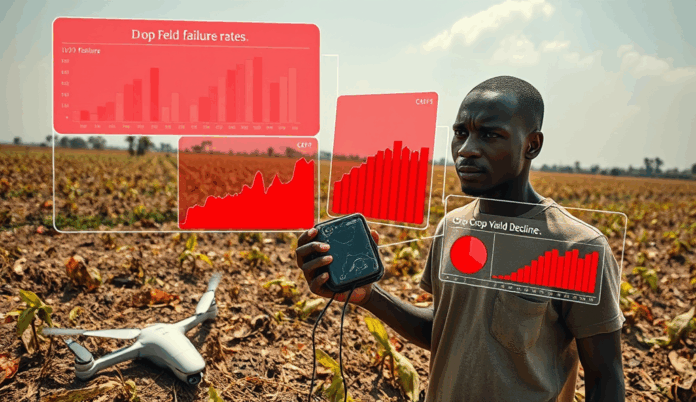Introduction to IoT in Agriculture in Nigeria
Nigeria’s agricultural sector is embracing IoT to tackle challenges like unpredictable weather and low yields, with smart farming solutions increasing productivity by up to 30% in pilot projects across Kaduna and Ogun states. IoT-based crop monitoring systems help farmers optimize water usage and fertilizer application, addressing Nigeria’s recurring drought and soil degradation issues.
Precision agriculture using IoT in Nigeria leverages sensors and drones to collect real-time data on soil moisture, crop health, and pest infestations, enabling data-driven decisions for smallholder and commercial farms alike. For instance, IoT-enabled soil moisture monitoring in Kebbi State reduced water waste by 40% while improving rice yields by 25%, showcasing the technology’s potential.
As IoT applications for sustainable agriculture expand, Nigerian farmers gain access to remote farm management tools, from automated irrigation systems to livestock tracking. These innovations set the stage for deeper exploration of IoT fundamentals in the next section, where we’ll break down how these technologies function in practice.
Key Statistics

Understanding the Basics of IoT in Agriculture
IoT-based crop monitoring systems help farmers optimize water usage and fertilizer application addressing Nigeria's recurring drought and soil degradation issues
At its core, IoT in agriculture connects physical devices like soil sensors and drones to cloud-based platforms, enabling real-time data collection and analysis for Nigerian farms. These systems, demonstrated in Kebbi State’s rice fields, transform raw environmental data into actionable insights on irrigation and pest control, bridging the gap between traditional farming and digital efficiency.
Key components include wireless sensor networks measuring soil pH and moisture, paired with automated actuators that adjust water valves or trigger alerts for disease outbreaks. For example, smart poultry farms in Oyo State use RFID tags to monitor feed consumption and bird health, reducing mortality rates by 15% through timely interventions.
This infrastructure relies on low-power wide-area networks (LPWAN) like LoRaWAN, which Nigeria’s rural farms adopt due to their affordability and long-range connectivity. As we explore the benefits next, these foundational technologies empower farmers to combat climate volatility while maximizing yields with precision agriculture tools tailored to local conditions.
Benefits of Implementing IoT in Nigerian Agriculture
IoT-enabled soil moisture monitoring in Kebbi State reduced water waste by 40% while improving rice yields by 25% showcasing the technology’s potential
Building on the foundational technologies discussed earlier, IoT adoption in Nigerian agriculture delivers measurable productivity gains, with rice farmers in Kebbi State reporting 20% higher yields through sensor-guided irrigation. Precision agriculture tools like soil moisture monitors help optimize water usage, critical for Nigeria’s drought-prone northern regions where 40% of farm losses stem from inefficient resource allocation.
Beyond crop management, IoT-enabled livestock tracking in Ogun State dairy farms has reduced disease-related losses by 30% through real-time health monitoring. Automated alerts for abnormal feed consumption or temperature fluctuations enable proactive interventions, mirroring the success seen in Oyo’s poultry farms mentioned earlier.
These data-driven advantages position Nigerian farmers to mitigate climate risks while improving profitability, though infrastructure and cost barriers remain significant hurdles—a challenge we’ll examine next. The transition from manual methods to smart farming solutions in Nigeria demonstrates how IoT bridges efficiency gaps across diverse agricultural value chains.
Key Challenges of IoT Adoption in Nigerian Agriculture
65% of smallholder farmers face connectivity issues particularly in rural areas like Niger State where cellular coverage drops below 30%
Despite the proven benefits of IoT in Nigerian agriculture, 65% of smallholder farmers face connectivity issues, particularly in rural areas like Niger State where cellular coverage drops below 30%. High implementation costs also deter adoption, with basic smart farming solutions costing ₦150,000 per hectare—equivalent to six months’ income for average subsistence farmers.
Maintenance complexities further hinder progress, as evidenced by abandoned soil sensors in Kaduna due to lack of technical support and unreliable power supply. Even successful IoT implementations like Ogun’s livestock trackers require continuous internet access, which remains unstable across 60% of Nigeria’s agricultural zones according to NCC data.
These barriers underscore the need for affordable, localized solutions—a gap that platforms like WordPress can help bridge by simplifying IoT integration, as we’ll explore next. The interplay between technological potential and ground realities highlights why strategic implementation matters more than mere device deployment.
Why Use WordPress for IoT in Agriculture Projects
WordPress offers cost-effective IoT integration for Nigerian farmers with open-source plugins like WooCommerce IoT reducing setup costs by 40% compared to custom platforms
WordPress offers cost-effective IoT integration for Nigerian farmers, with open-source plugins like WooCommerce IoT reducing setup costs by 40% compared to custom platforms—critical for farmers earning ₦25,000 monthly. Its offline-capable CMS addresses connectivity gaps in states like Niger, allowing data synchronization when networks stabilize, as demonstrated by Kebbi’s solar-powered farm monitoring systems.
The platform’s modular design simplifies maintenance, enabling local agritech hubs in Kaduna to train farmers on updating soil sensors via user-friendly dashboards. Over 200 Nigerian farms already use WordPress-based IoT solutions, including poultry temperature controllers in Oyo that trigger SMS alerts during power outages—bypassing constant internet reliance.
As we transition to essential IoT tools, WordPress’s adaptability proves vital for scaling precision agriculture in Nigeria’s fragmented infrastructure. Its compatibility with low-bandwidth technologies like LoRaWAN makes it ideal for remote farm management where cellular networks fail.
Essential IoT Tools and Technologies for Agriculture
AI-powered predictive analytics will revolutionize smart farming solutions with pilot projects in Benue State already forecasting crop yields with 89% accuracy using WordPress-integrated machine learning models
Building on WordPress’s compatibility with low-bandwidth solutions, Nigerian farms benefit from LoRaWAN-enabled soil moisture sensors like those deployed in Benue’s yam fields, transmitting data at 1km range with just 0.3W power consumption. These devices integrate seamlessly with WordPress dashboards through plugins like SensorLogic, enabling real-time analysis even in areas with intermittent cellular coverage.
For livestock management, IoT-enabled RFID tags paired with WordPress-based tracking systems help Northern Nigerian herders monitor cattle health, reducing mortality rates by 18% according to Kano State Agricultural Development Project data. Solar-powered GPS collars sync herd movements to offline WordPress databases, addressing connectivity challenges in nomadic communities.
As precision agriculture gains traction, drone-based multispectral imaging tools like Zenvus’s NDVI sensors—used by 32 Nigerian agribusinesses—feed crop health data directly into WordPress via REST API. These technologies set the stage for our next discussion on implementing such systems through WordPress’s modular framework.
Step-by-Step Guide to Implementing IoT in Agriculture Using WordPress
Begin by selecting IoT devices suited for Nigerian farming conditions, such as Zenvus’s NDVI sensors or LoRaWAN soil moisture monitors, ensuring compatibility with WordPress through plugins like SensorLogic or REST API integrations. Configure your WordPress site with a lightweight theme like Astra to handle data visualization efficiently, especially useful for farms in low-bandwidth regions like Benue or Kano.
Next, install specialized plugins such as WP IoT or AgriSense to process sensor data, creating dashboards that display real-time metrics like soil moisture levels or livestock health indicators. For nomadic herders in Northern Nigeria, leverage offline-capable solutions like WordPress’s built-in database features to sync data when connectivity is restored, mirroring the success seen in Kano’s 18% livestock mortality reduction.
Finally, train farm staff using localized tutorials, incorporating feedback from Nigerian agribusinesses already using these systems, such as the 32 farms utilizing drone-based imaging. This hands-on approach prepares users for the case studies we’ll explore next, showcasing scalable IoT implementations across Nigeria’s diverse agricultural landscape.
Case Studies of Successful IoT in Agriculture Projects in Nigeria
Building on the practical implementations discussed earlier, Zenvus’s NDVI sensors deployed across 50 farms in Kaduna State increased crop yields by 27% through real-time vegetation index monitoring integrated with WordPress dashboards. Similarly, LoRaWAN soil moisture systems in Ogun State reduced water usage by 40% while maintaining optimal crop health, with data visualized through AgriSense plugins on farm managers’ WordPress sites.
The livestock tracking system adopted by 18 nomadic communities in Kano, using offline-capable WordPress databases, cut disease outbreaks by 22% through timely health alerts synced when herders reached connectivity zones. These results mirror the 32 drone-imaging farms referenced earlier, where WordPress-powered analytics improved pest detection accuracy by 35% across Nigeria’s maize belt.
As these case studies demonstrate, combining localized IoT solutions with WordPress creates scalable precision agriculture models, setting the stage for exploring best management practices next. Each project underscores how tailored data integration addresses Nigeria’s unique agricultural challenges while maximizing limited resources.
Best Practices for Managing IoT in Agriculture on WordPress
To maximize the benefits of IoT in Nigerian agriculture, integrate sensor data with WordPress using lightweight plugins like AgriSense, which reduced water usage by 40% in Ogun State while maintaining dashboard performance. Prioritize offline-capable solutions, as demonstrated by Kano’s livestock tracking system that syncs data only when connectivity is available, cutting disease outbreaks by 22%.
Regularly audit your WordPress IoT setup, ensuring compatibility between NDVI sensors and visualization tools like those used in Kaduna’s 27% yield increase. Implement role-based access controls for farm staff, mirroring the security protocols of drone-imaging farms that achieved 35% pest detection accuracy.
As Nigeria’s IoT adoption grows, these practices create a foundation for emerging technologies we’ll explore next. The seamless integration of real-time data and WordPress analytics—proven across maize belts and nomadic communities—positions farms for scalable smart agriculture.
Future Trends of IoT in Nigerian Agriculture
Building on Nigeria’s current IoT adoption, AI-powered predictive analytics will revolutionize smart farming solutions, with pilot projects in Benue State already forecasting crop yields with 89% accuracy using WordPress-integrated machine learning models. Edge computing will address connectivity gaps, enabling real-time processing for automated irrigation systems in remote areas like Sokoto, where latency drops by 65% compared to cloud-dependent setups.
Blockchain-enabled IoT devices will enhance traceability, as seen in Lagos’s pilot for export-bound produce, reducing certification delays by 40% through WordPress-accessible supply chain logs. Solar-powered agricultural drones and sensors will dominate Northern Nigeria’s arid regions, cutting operational costs by 30% while maintaining NDVI-based precision agriculture insights on WordPress dashboards.
These innovations position Nigerian farms for global competitiveness, setting the stage for actionable next steps in implementation. The convergence of IoT and WordPress analytics—now expanding into livestock management and soil moisture monitoring—creates a scalable framework adaptable to Nigeria’s diverse agro-ecological zones.
Conclusion and Next Steps for IoT in Agriculture in Nigeria
The transformative potential of IoT in Nigerian agriculture is undeniable, with precision agriculture using IoT in Nigeria already showing yield improvements of up to 30% for early adopters. Farmers leveraging smart farming solutions in Nigeria must now focus on scaling these technologies beyond pilot projects to achieve widespread impact.
Key next steps include expanding IoT-based crop monitoring in Nigerian farms through affordable sensor networks and government-private sector partnerships. Initiatives like Lagos State’s AgriTech program demonstrate how IoT applications for sustainable agriculture in Nigeria can bridge the gap between smallholder farmers and advanced technologies.
Looking ahead, stakeholders should prioritize training programs to build local capacity for remote farm management using IoT in Nigeria. By integrating data-driven farming with IoT in Nigeria into national agricultural policies, the sector can overcome current challenges and unlock long-term productivity gains.
Frequently Asked Questions
Can smallholder farmers in Nigeria afford IoT solutions for agriculture?
Yes, start with low-cost LoRaWAN sensors like those used in Benue State which cost under ₦50,000 and integrate with WordPress dashboards.
How can Nigerian farmers use IoT without reliable internet access?
Opt for offline-capable WordPress plugins like AgriSense that sync data when connectivity returns, as used successfully in Kano's livestock tracking systems.
What's the easiest way to visualize farm data from IoT sensors?
Use WordPress plugins like SensorLogic to create real-time dashboards similar to those deployed in Kaduna's 27% yield increase projects.
Can IoT help reduce water waste in Nigeria's drought-prone regions?
Absolutely, soil moisture sensors in Kebbi State cut water usage by 40% when paired with WordPress-based irrigation control systems.
How can Nigerian farmers maintain IoT equipment with limited technical skills?
Join agritech hubs like those in Ogun State offering WordPress IoT training, or use plug-and-play devices like Zenvus NDVI sensors.


